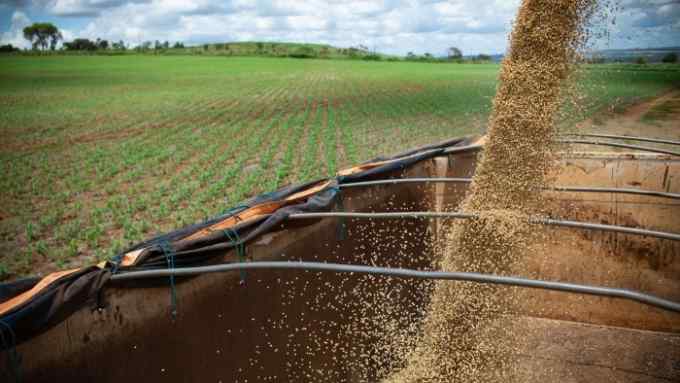Regenerative agriculture sparks venture capital interest

Roula Khalaf, Editor of the FT, selects her favourite stories in this weekly newsletter.
Regenerative agriculture is based on the idea that, as well as producing food, farming should also benefit the land’s biodiversity, and its water and soil quality.
Definitions differ, but practices typically involve minimising ploughing to reduce disturbance to the soil, and annually rotating the types of crops planted on the same site to increase the diversity of nutrients and minimise pests. However, unlike organic farming, regenerative agriculture permits the limited use of artificial fertilisers and pesticides.
“It’s a different way of thinking about the land,” says Mark Durno, agri-food managing partner at venture capital group Rockstart — and a former farmer. “It’s about thinking of it as something that’s alive, rather than as a blank canvas.”
Now, the phrase “regenerative agriculture” is firmly cemented in corporate parlance, too — cropping up in the sustainability plans of big food companies such as Nestlé, Unilever and Danone.
Off the back of this rising interest, there are also a growing number of tech start-ups building regenerative agriculture tools — and investors are increasingly willing to channel money to them. Between 2021 and 2023, VC funds poured $1.4bn into regenerative agriculture start-ups, according to data provider Dealroom — a 46 per cent increase on the three years prior.
But does tech have a role to play in a movement that is, at its heart, low-tech — or at least sceptical about high-tech intensive agriculture?
One of the main areas where tech companies are active is the development of digital tools to issue carbon credits to farmers. Regenerative agriculture can, in theory, increase the amount of carbon sequestered in the soil, enabling farmers to then earn carbon credits.
The voluntary carbon credit market — where companies aim to offset their emissions by funding schemes that draw down carbon — is currently worth about $2bn but could exceed $250bn by 2050, according to research by Morgan Stanley.
Danish company Agreena is one of the start-ups now working on tools to monitor the amount of carbon sequestered and issues carbon credits. Its chief executive, Simon Haldrup, says that technology’s role is to provide the infrastructure that makes regenerative agriculture financially viable.
“The whole foundation of regenerative agriculture is super low-tech,” he says. “Then, there are the layers downstream, the monitoring and verification. That is all about technology and data because it’s a financial infrastructure that’s being built.”
Although Agreena has received VC funding, Haldrup says that companies such as his “don’t play well with the general playbooks of most VCs”. Regenerative agriculture businesses have longer time horizons than the software companies that VCs typically invest in, Haldrup says — making it hard for exit-focused investors to back the businesses.
But, beyond carbon credits, investors also cite opportunities in the tools that help farmers work out which techniques will work best on their land.
“If you’re a farmer and you’re going to transition to regenerative agriculture, the biggest barrier is knowledge and understanding best practices,” explains Durno. “We look towards things like generative AI [artificial intelligence] as an interface for farmers to get simpler agronomy advice.”
Leslie Kapin, director of impact for VC company Astanor Ventures, says start-ups working on bio-based alternatives to conventional synthetic fertilisers, pesticides and herbicides can also fall within the regenerative agriculture bucket.
Fertiliser is a multi-billion-dollar industry, and finding alternatives could make for a lucrative opportunity. New technologies can also allow farmers to spray existing fertilisers and pesticides more precisely, thereby reducing the amount used.
Ken Giller, emeritus professor of plant production systems at the University of Wageningen in the Netherlands, says that, while scientists are divided on the legitimacy of soil-based carbon credits — in part because of difficulties in quantifying the amount of additional carbon sequestered — he is most convinced by technologies such as green ammonia.
A key fertiliser ingredient, ammonia is often derived from fossil fuels through a carbon-intensive process. However, so-called green ammonia has a much smaller carbon footprint.
For Giller, a central problem with investors piling into regenerative agriculture is that, at its heart, the practices do not deliver increased profit margins — a dynamic that no amount of technology can solve. “You can design a perfect crop rotation system which would help to build more soil organic matter,” he says, “but that might actually mean leaving out some of the more lucrative crops.”
He also cautions that the surge in popularity of regenerative agriculture may be for the wrong reasons. “Regenerative agriculture is a branding that people find very attractive,” he says, warning that companies’ interest in the term needs to be “verifiable and measurable,” rather than a marketing exercise.
Yet investors are bullish about both the ecological impact and financial returns that regenerative agriculture tools can bring. Kapin argues that incoming regulation and sustainability targets will make the sector still more appealing, with the EU’s Green Deal, in particular, targeting greater biodiversity and healthier soils. “That’s the reason why we invest: because of the sizeable market we’re seeing,” she says.

Comments